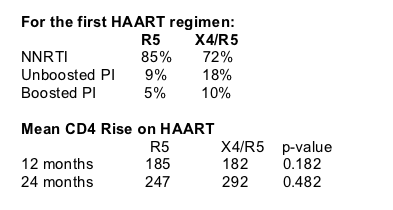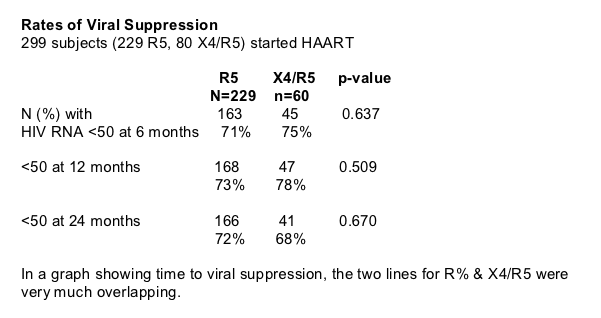 |
 |
 |
| |
Affect of R5 & X4/R5 Tropism on CD4 Count, HIV-RNA, and Response to HAART
|
| |
| |
"CXCR4/Mixed-Tropic HIV-1 is Associated with More Rapid CD4 Cell Decline Compared with CCR5-Tropic Virus in Antiretroviral-Naive Individuals, but No Difference in Response to HAART Response Between R5 & X4 HIV"
Reported by Jules Levin
ICAAC, Sept 27-30, 2006, San Francisco
"HIV Co-receptor tropism in treatment-naive patients: impact on CD4 decline & subsequent reponse to HAART"
L. J. WATERS, S. MANDALIA, A. WILDFIRE, B. GAZZARD, G. MOYLE;
Chelsea & Westminster Hosp., London, United Kingdom.
Laura Waters reported in an oral presentation at ICAAC on a study that included 402 treatment-naive patients of whom 325 had R5 only virus and 76 patients had mixed X4/R5 HIV. Waters said there are two potential roles for tropism testing: guiding therapy decisions, and predicting disease progression. If X4 or X$/r% mixed/dual HIV is associated with accelerated CD4 decline then perhaps earlier HAART therapy may be considered. The aim of this study was to see if there was a difference in CD4 decline between patients who have R5 and mixed X4/R5 HIV before starting HAART, and to see if there was a difference in response to HAART (CD4 rise, % <50 c/ml, time to HIV RNA <50 c/ml) between the patients with X4 vs those with R5 HIV. The ViroLogic Phenosense Assay was used.
Waters reported that patients with X4 HIV-1 experienced a more rapid CD4 decline than those with R5 (adjusted for baseline viral load) before going on HAART. But CD4 rise was similar over 96 weeks of HAART, and similar proportions of patients with X4 and R5 HIV achieved viral suppression at year 1 and year 2. Time to viral suppression was the same for R5 and X4/R5 mixed/dual virus when adjusted for baseline viral load.
In her talk Waters first reviewed data from 5 studies on the prevalence of co-receptor use in HIV+ individuals. The prevalence of X4/R5 mixed/dual tropism in ART-naives ranged from 6% to 17% in 4 studies (Maraviroc phase 2 naives : 6%; Homer cohort (n=979) naives 17%; Chelsea & Westminster (naive/experienced (n=563) 15%; GSK (n=299) naives 12%). But in a more experienced patient population it was 34% X4/R5 prevalence in TORO1-2, and 48% in a Virologic report.
I think she was referring to the larger patient cohort at Chelsea Westminster of 563 patients where they got the 402 patients for this analysis, where the mean CD4 count was higher for the R5 tropic patients 307 vs 231 for the X4/R5 mixed/dual tropic patients (p=0.007). R5 prevalence was 59% among patients with <200 CD4s, but 84% for patients with 100-300 CD4s and 83% for patients with >300 CD4s. Average HIV RNA was 35,000 for R5 tropic patients vs 66,000 for X4/R5 mixed/dual tropic patients.
RESULTS
402 naive subjects were tested for tropism:
326 R5
73 X4/R5 mixed/dual tropic
3 had pure X4
340 commenced HAART by August 2006:
51 were excluded from the analysis
229 R5
60 X4/mixed/dual
62 remained off therapy.
About 90% were men
70% were white
12% Black
14-20% other
The average CD4 count (IQR) was 325 for R5 patients & 203 for X4/R5 patients (p<0.001). HIV RNA (IQR) was 39,385 (range: 13,358-120,818for the R5-tropic vs 142,568 (47,186-275,726) for the X4/R5 tropic. About 80% were clade B.
The CD4 decline was significantly greater in the naive X4/R5 group at month 12 (p=0.026). On the graph Waters presented CD4 decline appeared to be about 50 cells for the R5/X4 group vs almost 200 for the R5 group.


|
| |
|
 |
 |
|
|